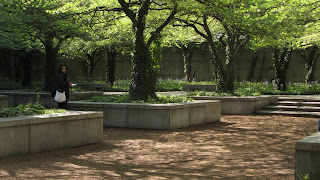“Modernism is efficient because it aims for simplification.
The central assumption is that technological solutions are universal, and so
are independent of social context. This is what makes it appealing—mass production
for us all. But modernist thinking inevitably leads to arrogance about the
social and natural world.” –Tim O’Riordan, Susanne Stoll-Kleemann; Biodiversity, Sustainability and Human
Communities
(Kiley landscape, Chicago Art Institute)
Dan Kiley was a prominent 20th century landscape
architect that represented the height of modernism. His designs complemented sleek
modern architecture and were clean, gridded—and mostly bereft of plant biodiversity.
This use of mass plantings of the same species were common to Italian, French, Modernist
and Minimalist traditions; and still influence landscapes today. Many city
landscape ordinances promote biodiversity in plantings by encouraging the use
of multiple species—mostly to prevent urban forestry disasters that occur with single-tree
use (Dutch elm disease, Emerald ash borer, etc.).
Ecologists have documented the decline of native plant species
diversity in urban areas as well. As shown in the chart below, McKinney (2002) gleaned
from the available literature these observations:
that species richness declines the closer one gets to dense urban areas,
and the urban biota changes as well.
Zipperer and Gunstenspergen did their own
empirical research by comparing both native and non-native species richness in
five community gradients. Their conclusions showed a slight revision to
McKinney’s model, one that shows native species richness declining as it
approaches the urban core, and non-native species increasing as it approaches
the urban core.
To enhance native urban biodiversity, US federal agencies (EPA,
USDA, and DOT--in some states) are promoting the use of native plants; as well
as NGO’s such as the National Wildlife Federation and Audubon. Wilde, Gandhi,
and Colson (2015) propose that landscape plants (the ones that are primarily
used in urban areas) should be bred with ecological function. Many landscape
plant species are bred for form and ornamental characteristics (larger or
more flowers, fruit, or other showy aspects). Similar to our shiny modern
grocery store fruit-- taste and nutrition are bred out, but consumer curb-appeal
is in. Wilde et al propose not only to scale up the use of native plants in
urban landscapes, but to ensure that their genotypes also include the
pollinator services and genetic diversity of their rural cousins.



No comments:
Post a Comment